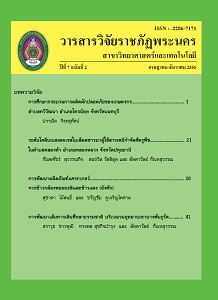การพัฒนาผลิตภัณฑ์แครกเกอร์จากข้าวกล้องหอมมะลิ และข้าวแดง (อังคัก)
Keywords:
แครกเกอร์, ข้าวกล้องหอมมะลิ, ข้าวแดง อังคัก, โมนาโคลิน เค, ซิตรินิน, cracker, brown rice, red rice ankak, monacolin K, citrininAbstract
งานวิจัยนี้มีวัตถุประสงค์เพื่อพัฒนาผลิตภัณฑ์แครกเกอร์ โดยการทดแทนแป้งสาลีด้วยแป้งข้าวกล้อง หอมมะลิ ที่ร้อยละ 0 10 20 30 และ 40 (ของนํ้าหนักแป้งสาลีทั้งหมด) จากนั้นคัดเลือกแครกเกอร์ที่มีคุณภาพดี นำมาทดแทนแป้งสาลีด้วยข้าวแดงหรืออังคัก ผลการทดลองพบว่า การทดแทน แป้งสาลีด้วยแป้งข้าวกล้อง หอมมะลิ ส่งผลให้แครกเกอร์ มีอัตราการขยายตัว ค่าสี L* และ b* มีแนวโน้มลดลง ในขณะที่ค่าความกรอบ และ ค่าสี a* เพิ่มขึ้น เมื่อเพิ่มระดับการทดแทนแป้งสาลี การประเมินคุณภาพทางประสาทสัมผัส พบว่าการ ทดแทนแป้งสาลีด้วยแป้งข้าวกล้องหอมมะลิที่ร้อยละ 10-30 คะแนนความชอบด้านลักษณะปรากฏ กลิ่นรส และความชอบรวมไม่มีความแตกต่างกับแครกเกอร์จากแป้งสาลีล้วน (p>0.05) แต่เมื่อเพิ่มระดับการทดแทน แป้งสาลีเป็นร้อยละ 40 คะแนนความชอบในทุกคุณลักษณะมีแนวโน้มลดลง (p≤0.05) ดังนั้นจึงนำแครกเกอร์ที่ ทดแทนแป้งสาลีด้วยแป้งข้าวกล้องหอมมะลิที่ร้อยละ 30 พัฒนาโดยทดแทนด้วยข้าวแดงในรูปแบบผงและ แบบสารสกัดที่ร้อยละ 0 2, 4, 6 และ 8 ตามลำดับ พบว่า ค่าการขยายตัว ค่าสี L* และ b* มีแนวโน้มลดลง (p≤0.05) แต่ค่าความกรอบ ค่าสี a* เพิ่มขึ้น (p≤0.05) เมื่อเพิ่มระดับของการทดแทน การประเมินคุณภาพทาง ประสาทสัมผัส พบว่าเมื่อเพิ่มระดับการทดแทนคะแนนความชอบของทุกคุณลักษณะลดลง (p≤0.05) โดยเฉพาะ อย่างยิ่งด้านรสชาติ ซึ่งมีความขม ผู้ทดสอบชิมยอมรับผลิตภัณฑ์แครกเกอร์ที่ทดแทนแป้งสาลีด้วยข้าวกล้อง หอมมะลิร้อยละ 30 ร่วมกับข้าวแดงที่ร้อยละ 2 โดยการใช้ข้าวแดงในรูปแบบสารสกัด แครกเกอร์จะมี คะแนนความชอบในทุกๆ คุณลักษณะสูงกว่าการใช้ข้าวแดงแบบผง ในขณะที่คุณภาพทางเคมีและกายภาพมี ค่าใกล้เคียงกัน แครกเกอร์ที่ใช้สารสกัดข้าวแดงร้อยละ 2 มีปริมาณสารโมนาโคลิน เค ในผลิตภัณฑ์ประมาณ 0. 393 มิลลิกรัมต่อ 100 กรัมแครกเกอร์ ในขณะที่ตรวจไม่พบสารซิตรินิน จากนั้นนำแครกเกอร์ที่ทดแทน แป้งสาลีด้วยแป้งข้าวหอมมะลิที่ร้อยละ 30 ร่วมกับสารสกัดข้าวแดง ร้อยละ 2 ไปพัฒนาด้านกลิ่นรสและ รูปร่าง พบว่าแครกเกอร์รสชีส และรูปร่างแบบแท่ง ได้รับการยอมรับจากผู้ทดสอบชิมมากที่สุด
Development of cracker from Hom Mali brown rice and red rice (ankak)
The objectives of this research were to develop cracker products by using brown rice flour substituted for wheat flour at 0, 10, 20, 30 and 40 % (weight of total wheat flour) respectively. Selecting the cracker which had a good quality substituting for wheat flour with red rice or ankak. The results showed that the expansion ratio, L* and b* value decreased, while the crispiness and a* value increased, when increased the substitution level of wheat flour. The sensory evaluation was found that using of brown rice flour substituted for wheat flour at 10–30 %, there was not significantly difference the appearance, flavor and over all preference score (p>0.05) comparing with cracker products which made from wheat flour. When the substitution level increased at 40 %, the preference score of all attributes tended to decrease (p≤0.05). Therefore, the cracker was substituted for wheat flour with brown rice flour at 30 % and then developed by substituting for red rice which had 2 form; red rice powder and red rice extract solution at 0, 2, 4, 6 and 8%, respectively. The results revealed that the expansion ratio, L* and b* value tended to decrease(p≤0.05) but the crispiness and a* value increased, when the substitution level increased. The sensory evaluation was found that when the substitution level increased, the preference score of all attributes decreased, especially bitter taste. The panelist accepted cracker products substituted for wheat flour with red rice at 2%. The use of red rice in the form of extract solution, the preference score in all attributes was higher than the form of red rice powder, while the qualities of chemical and physical were the same. The cracker substituted for wheat flour with red rice extract solution contained the monacolin K about 0.393 milligrams /100 grams cracker, but the citrinin was not found. After that, the cracker products which substituted for wheat flour with brown rice 30 % and red rice extract solution 2%, developed in flavor and shape. It was found that the cheese flavor cracker and the bar shape were the most accepted by the panelists.Downloads
Issue
Section
License
โปรดกรอกเอกสารและลงนาม "หนังสือรับรองให้ตีพิมพ์บทความในวารสารวิจัยมหาวิทยาลัยราชภัฏพระนคร สาขาวิทยาศาสตร์และเทคโนโลยี" ก่อนการตีพิมพ์




